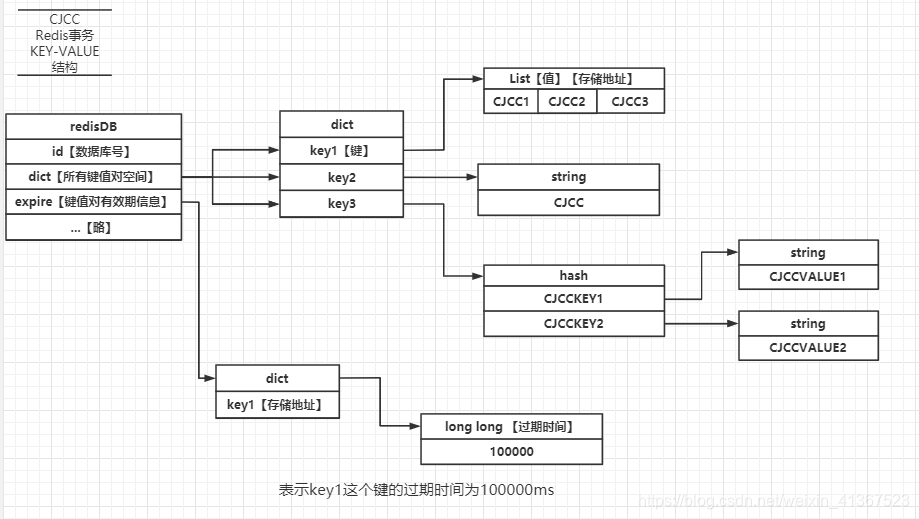文章目录
Redis-删除策略以及逐出(淘汰)策略篇
Redis简介
Redis 是 C 语言开发的一个高性能键值对(key -value) 内存数据库,可以用作数据库,缓存和消息中间件等。
特点
-
作为内存数据库,它的性能非常优秀,数据存储在内存当中,读写速度非常快,支持并发
10W QPS(每秒查询次数),单进程单线程,是线程安全的,采用IO多路复用机制。 -
丰富的数据类型,支持字符串,散列,列表,集合,有序集合等,支持数据持久化。可以将内存中数据保存在磁盘中,重启时加载。
-
主从复制,哨兵,高可用,可用作分布式锁。可以作为消息中间件使用,支持发布订阅。
删除策略以及逐出策略
什么是过期数据?
Redis 是一种内存数据库,所有数据都存放在内存中,内存中的数据可以通过 TTL 指令获取其状态。
如:
- XX:具有时效性的数据,通过下列命令来定义:
setex key seconds valueexpire key secondsexpireat key timestamppexpire key millisecondspexpireat key milliseconds-timestamp

- -1:永久有效的数据

- -2:已过期 | 未定义 | 已删除的数据

redis存储 key-value 结构:
代码
/* Redis database representation. There are multiple databases identified
* by integers from 0 (the default database) up to the max configured
* database. The database number is the 'id' field in the structure. */
typedef struct redisDb {
dict *dict; /* 数据库键空间,保存所有键值对信息 The keyspace for this DB */
dict *expires; /* 键的有效期信息 Timeout of keys with a timeout set */
dict *blocking_keys; /* Keys with clients waiting for data (BLPOP)*/
dict *ready_keys; /* Blocked keys that received a PUSH */
dict *watched_keys; /* 实现监控 WATCHED keys for MULTI/EXEC CAS */
int id; /* 数据库号,标记是哪一个数据库的 Database ID */
long long avg_ttl; /* Average TTL, just for stats */
unsigned long expires_cursor; /* Cursor of the active expire cycle. */
list *defrag_later; /* List of key names to attempt to defrag one by one, gradually. */
} redisDb;
在这里用到了redisDB这个结构体的:
dict *dict;—>数据库键空间,保存所有键值对信息dict *expires;—>键的有效期信息int id;—>数据库号
如图一:

过期的数据是否真的被删除了?
过期数据:指的是曾经设置过过期时间的数据,到达了它的过期时间失效。
当 redis 需要处理某条数据的时候,发送一条指令给 CPU,CPU 轻轻松松就可以搞定,相对来说不会占用太多时间,但是如果有多个 redis 同时发送了非常多的增删查改指令过来,那 CPU 压力就会变得非常大,造成性能下降,所有操作都在排队等着 CPU 空闲处理指令。那么,我们在这里能不能做一个优化,查数据,加数据,改数据这部分还是得正常进来处理,但是过期数据貌似就不是一个很着急的事情了。如果内存空间也不是很紧张,没达到阈值,那可以先放在内存里,等有空的时间再删掉。也就是说,当这些数据过期以后,实际上还是先放在内存里等到要删的时候再去删它。而具体怎么删,Redis 会提供相应的删除策略。
Redis提供的删除策略
Redis 提供了三种删除策略:1. 定时删除 | 2. 惰性删除 | 2. 定期删除
数据删除策略的目标就是在
内存和CPU占用之间寻找一种平衡,避免某一边压力过大造成整体性能下降,甚至引发服务器宕机或内存泄露。
定时删除
当 key 设置过期时间的时候,创建一个定时器事件,当 key 过期时间到达时,由定时器任务立即执行对 key 的删除操作,删除操作先删除存储空间的,再移除掉 expire 的 key
优点:节约内存,到时就删除,快速释放掉不必要的内存占用
缺点:CPU 压力大,无论 CPU 此时负载量多高,都会去占用 CPU 进行 key 的删除操作,会影响 Redis 服务器响应时间和吞吐量,是一种比较低效的方式
结论:用 CPU 性能换取内存空间,时间换空间

惰性删除|被动删除
数据到达超时时间的,不立即处理,等下次访问该数据的时候,再去删除(操作会执行expireIfNeeded()函数去检查)
优点:不占用 CPU 节约 CPU 性能,只在获取访问key的时候才判断是否过期,过期则删除,只会删除当前获取的这一个key,其他的key还是保持原样
缺点:内存占用大,如果一直没有获取它,那么数据就会长期占用内存空间,当有大量的key没有被使用到,也造成了大量内存浪费,对内存数据库来说,也不太友好
结论:空间换时间

过期删除调用的几个主要函数 db.c
int expireIfNeeded(redisDb *db, robj *key)int keyIsExpired(redisDb *db, robj *key)long long getExpire(redisDb *db, robj *key)
notifyKeyspaceEvent(NOTIFY_EXPIRED,"expired",key,db->id);server.lazyfree_lazy_expire ? dbAsyncDelete(db,key) : dbSyncDelete(db,key);
int expireIfNeeded(redisDb *db, robj *key) {
if (!keyIsExpired(db,key)) return 0; //未过期的key
/* If we are running in the context of a slave, instead of
* evicting the expired key from the database, we return ASAP:
* the slave key expiration is controlled by the master that will
* send us synthesized DEL operations for expired keys.
*
* Still we try to return the right information to the caller,
* that is, 0 if we think the key should be still valid, 1 if
* we think the key is expired at this time. */
if (server.masterhost != NULL) return 1;
/* Delete the key */
server.stat_expiredkeys++;
propagateExpire(db,key,server.lazyfree_lazy_expire);
notifyKeyspaceEvent(NOTIFY_EXPIRED,
"expired",key,db->id);
//删除操作
int retval = server.lazyfree_lazy_expire ? dbAsyncDelete(db,key) :
dbSyncDelete(db,key);
if (retval) signalModifiedKey(NULL,db,key);
return retval;
}
定期删除|主动删除
前面说的两种方案1.时间换空间,2.空间换时间都是两个极端方法,为避免前面方案带来的问题,Redis 引入了定期删除策略(是他们的一个比较折中的方案)
周期性轮询
Redis库中的时效性数据,采取随机抽取的策略,利用过期数据占比的方式控制删除频度。
- 在Redis服务器初始化时,读取
server.hz的值,默认值为10。- 定时轮询服务器,每秒钟执行
server.hz次serverCron()函数。 databaseCron()在后台轮询处理 16 个 redis 数据库的操作,如这里的过期 key 的处理activeExpireCycle(),对每个数据库的expire空间进行检测,每次执行250ms/server.hz
- 定时轮询服务器,每秒钟执行
- 随机选取一批
expire空间的 key(redis有16个数据库,从0号数据库开始---15号数据库)- 删除这批 key 中已过期的
- 如果这批 key 中已过期的占比超过25%,那么再重复执行步骤一。(
循环到小于25%结束当前数据库的删除) - 如果这批 key 中已过期的占比 ≤ 25%,检测下一个数据库的
expire空间(current_db++)
用info命令查看相关配置参数,如:server.hz配置

代码位置:
server.c
/*
This is our timer interrupt, called server.hz times per second.
Here is where we do a number of things that need to be done asynchronously.
For instance:
Active expired keys collection (it is also performed in a lazy way on lookup).
..............
*/
int serverCron(struct aeEventLoop *eventLoop, long long id, void *clientData){
/* Handle background operations on Redis databases. */
databasesCron();
//略............
}
server.c
/*
This function handles 'background' operations we are required to do incrementally in Redis databases, such as active key expiring, resizing, rehashing.
*/
void databasesCron(void) {
/* Expire keys by random sampling. Not required for slaves
* as master will synthesize DELs for us. */
if (server.active_expire_enabled) {
if (iAmMaster()) {
activeExpireCycle(ACTIVE_EXPIRE_CYCLE_SLOW);
} else {
expireSlaveKeys();
}
}
//略............
}
expire.c
void activeExpireCycle(int type){
//代码太长了不放了,主要执行流程是
随机选取一批expire空间的key(从0号数据库开始---15号数据库)
删除这批key中已过期的
如果这批key中已过期的占比超过25%,那么再重复执行步骤一。(`循环到小于25%结束当前数据库的删除`)
如果这批key中已过期的占比 ≤ 25%,检测下一个数据库的expire空间(`current_db++)
}
除了主动淘汰的频率外,Redis 对每次淘汰任务执行的最大时长也有一个限定,这样保证了每次主动淘汰不会过多阻塞应用请求,以下是这个限定计算公式:
#define ACTIVE_EXPIRE_CYCLE_SLOW_TIME_PERC 25 /* Max % of CPU to use. */
/* Adjust the running parameters according to the configured expire
* effort. The default effort is 1, and the maximum configurable effort
* is 10. */
unsigned long effort = server.active_expire_effort-1, /* Rescale from 0 to 9. */
unsigned long config_cycle_slow_time_perc = ACTIVE_EXPIRE_CYCLE_SLOW_TIME_PERC + 2*effort;
/* We can use at max 'config_cycle_slow_time_perc' percentage of CPU
* time per iteration. Since this function gets called with a frequency of
* server.hz times per second, the following is the max amount of
* microseconds we can spend in this function. */
timelimit = config_cycle_slow_time_perc*1000000/server.hz/100;
结论:CPU 性能占用设置有峰值,检测频度可自定义设置,内存压力不是很大,长期占用内存的冷数据会被持续清理(周期性随机抽查,重点抽查)
删除策略比对
- 定时删除(时间换空间)
- 节约内存无占用
- 不分时段占用 CPU 资源,频度高
- 惰性删除(空间换时间)
- 内存占用高
- 延迟执行,不会一直占用CPU资源,CPU 压力小,频度低
- 定期删除(周期性随机抽查)
- 内存定期随机清理
- 每秒花费固定 CPU 资源维护内存(清除过期数据)
逐出(淘汰)策略
在Redis 中经常会进行数据的增删查改操作,那么如果在添加数据的时候遇到了内存不足,该怎么办?在前面用的删除策略可以避免出现这种情况吗?
实际上,在前面所说的删除策略,它针对的是expire命令进行的操作,也就是说那些具有时效性的数据(已经过期,并且还在占用内存的数据),我们在这里说的是针对那些并没有过期,或者是内存中的数据没有一个带有有效期,全是永久性数据,这时候删除策略就不起作用了,所以这个时候内存满了我们再去插入数据到内存是怎么做?
介绍
Redis在进行存储操作的时候,会先干一件事,在执行每一个命令前都会去调用freeMemoryIfNeeded(void)方法去检测内存是否充足,如果内存不满足新加入数据最低存储要求,则需要临时删除一些数据为当前数据腾出存储空间。清理数据的方策叫做逐出(淘汰)算法。
逐出(淘汰)算法不是100%能清理出足够的可使用的内存空间,如果不成功则反复执行。当对所有数据尝试完成后,还是不能达到要求的话,就会报错。
步骤大致如下:
redis.windows-service.conf|redis.conf中配置maxmemory <bytes>限制内存使用量为100mb–>maxmemory 100mb,默认值设置为 0 则表示内存不限制,通常设置占物理内存的50%以上

redis.windows-service.conf|redis.conf中配置maxmemory-samples x每次选取删除数据的个数,选取数据时并不会全库扫描而导致严重的性能消耗降低读写性能,因此采用随机获取数据的方式作为待检测删除数据。

redis.windows-service.conf|redis.conf中配置maxmemory-policy noeviction删除策略,默认是noeviction当redis内存超出限制时,触发逐出(淘汰)机制,对被挑选出来的数据进行删除。

代码流程:
redis用int processCommand(client *c)函数处理每条命令,在这个函数里回去调用int freeMemoryIfNeededAndSafe(void)方法来判断内存空间
int processCommand(client *c) {
//..............略
/* Handle the maxmemory directive.
*
* Note that we do not want to reclaim memory if we are here re-entering
* the event loop since there is a busy Lua script running in timeout
* condition, to avoid mixing the propagation of scripts with the
* propagation of DELs due to eviction. */
if (server.maxmemory && !server.lua_timedout) {
int out_of_memory = freeMemoryIfNeededAndSafe() == C_ERR;
/* freeMemoryIfNeeded may flush slave output buffers. This may result
* into a slave, that may be the active client, to be freed. */
if (server.current_client == NULL) return C_ERR;
/* It was impossible to free enough memory, and the command the client
* is trying to execute is denied during OOM conditions or the client
* is in MULTI/EXEC context? Error. */
if (out_of_memory &&
(c->cmd->flags & CMD_DENYOOM ||
(c->flags & CLIENT_MULTI &&
c->cmd->proc != execCommand &&
c->cmd->proc != discardCommand)))
{
flagTransaction(c);
addReply(c, shared.oomerr);
return C_OK;
}
/* Save out_of_memory result at script start, otherwise if we check OOM
* untill first write within script, memory used by lua stack and
* arguments might interfere. */
if (c->cmd->proc == evalCommand || c->cmd->proc == evalShaCommand) {
server.lua_oom = out_of_memory;
}
}
//..............略
}
int freeMemoryIfNeededAndSafe(void)则会去调用真正判断内存的freeMemoryIfNeeded()函数来判断当前使用的内存是否超过了最大使用内存
/* This is a wrapper for freeMemoryIfNeeded() that only really calls the
* function if right now there are the conditions to do so safely:
*
* - There must be no script in timeout condition.
* - Nor we are loading data right now.
*
*/
int freeMemoryIfNeededAndSafe(void) {
if (server.lua_timedout || server.loading) return C_OK;
return freeMemoryIfNeeded();
}
int freeMemoryIfNeeded(void)这个函数开始进行内存计算,进一步选出需要淘汰的键
/* This function is periodically called to see if there is memory to free
* according to the current "maxmemory" settings. In case we are over the
* memory limit, the function will try to free some memory to return back
* under the limit.
*
* The function returns C_OK if we are under the memory limit or if we
* were over the limit, but the attempt to free memory was successful.
* Otehrwise if we are over the memory limit, but not enough memory
* was freed to return back under the limit, the function returns C_ERR. */
int freeMemoryIfNeeded(void) {
int keys_freed = 0;
/* By default replicas should ignore maxmemory
* and just be masters exact copies. */
if (server.masterhost && server.repl_slave_ignore_maxmemory) return C_OK;
size_t mem_reported, mem_tofree, mem_freed;
mstime_t latency, eviction_latency, lazyfree_latency;
long long delta;
int slaves = listLength(server.slaves);
int result = C_ERR;
/* When clients are paused the dataset should be static not just from the
* POV of clients not being able to write, but also from the POV of
* expires and evictions of keys not being performed. */
if (clientsArePaused()) return C_OK;
if (getMaxmemoryState(&mem_reported,NULL,&mem_tofree,NULL) == C_OK)
return C_OK;
mem_freed = 0;
latencyStartMonitor(latency);
if (server.maxmemory_policy == MAXMEMORY_NO_EVICTION)
goto cant_free; /* We need to free memory, but policy forbids. */
while (mem_freed < mem_tofree) {
int j, k, i;
static unsigned int next_db = 0;
sds bestkey = NULL;
int bestdbid;
redisDb *db;
dict *dict;
dictEntry *de;
if (server.maxmemory_policy & (MAXMEMORY_FLAG_LRU|MAXMEMORY_FLAG_LFU) || server.maxmemory_policy == MAXMEMORY_VOLATILE_TTL)
{
struct evictionPoolEntry *pool = EvictionPoolLRU;
while(bestkey == NULL) {
unsigned long total_keys = 0, keys;
/* We don't want to make local-db choices when expiring keys,
* so to start populate the eviction pool sampling keys from
* every DB. */
for (i = 0; i < server.dbnum; i++) {
db = server.db+i;
dict = (server.maxmemory_policy & MAXMEMORY_FLAG_ALLKEYS) ? db->dict : db->expires;
if ((keys = dictSize(dict)) != 0) {
evictionPoolPopulate(i, dict, db->dict, pool);
total_keys += keys;
}
}
if (!total_keys) break; /* No keys to evict. */
/* Go backward from best to worst element to evict. */
for (k = EVPOOL_SIZE-1; k >= 0; k--) {
if (pool[k].key == NULL) continue;
bestdbid = pool[k].dbid;
if (server.maxmemory_policy & MAXMEMORY_FLAG_ALLKEYS) {
de = dictFind(server.db[pool[k].dbid].dict,
pool[k].key);
} else {
de = dictFind(server.db[pool[k].dbid].expires,
pool[k].key);
}
/* Remove the entry from the pool. */
if (pool[k].key != pool[k].cached)
sdsfree(pool[k].key);
pool[k].key = NULL;
pool[k].idle = 0;
/* If the key exists, is our pick. Otherwise it is
* a ghost and we need to try the next element. */
if (de) {
bestkey = dictGetKey(de);
break;
} else {
/* Ghost... Iterate again. */
}
}
}
}
/* volatile-random and allkeys-random policy */
else if (server.maxmemory_policy == MAXMEMORY_ALLKEYS_RANDOM ||
server.maxmemory_policy == MAXMEMORY_VOLATILE_RANDOM)
{
/* When evicting a random key, we try to evict a key for
* each DB, so we use the static 'next_db' variable to
* incrementally visit all DBs. */
for (i = 0; i < server.dbnum; i++) {
j = (++next_db) % server.dbnum;
db = server.db+j;
dict = (server.maxmemory_policy == MAXMEMORY_ALLKEYS_RANDOM) ?
db->dict : db->expires;
if (dictSize(dict) != 0) {
de = dictGetRandomKey(dict);
bestkey = dictGetKey(de);
bestdbid = j;
break;
}
}
}
/* Finally remove the selected key. */
if (bestkey) {
db = server.db+bestdbid;
robj *keyobj = createStringObject(bestkey,sdslen(bestkey));
propagateExpire(db,keyobj,server.lazyfree_lazy_eviction);
/* We compute the amount of memory freed by db*Delete() alone.
* It is possible that actually the memory needed to propagate
* the DEL in AOF and replication link is greater than the one
* we are freeing removing the key, but we can't account for
* that otherwise we would never exit the loop.
*
* AOF and Output buffer memory will be freed eventually so
* we only care about memory used by the key space. */
delta = (long long) zmalloc_used_memory();
latencyStartMonitor(eviction_latency);
if (server.lazyfree_lazy_eviction)
dbAsyncDelete(db,keyobj);
else
dbSyncDelete(db,keyobj);
signalModifiedKey(NULL,db,keyobj);
latencyEndMonitor(eviction_latency);
latencyAddSampleIfNeeded("eviction-del",eviction_latency);
delta -= (long long) zmalloc_used_memory();
mem_freed += delta;
server.stat_evictedkeys++;
notifyKeyspaceEvent(NOTIFY_EVICTED, "evicted",
keyobj, db->id);
decrRefCount(keyobj);
keys_freed++;
/* When the memory to free starts to be big enough, we may
* start spending so much time here that is impossible to
* deliver data to the slaves fast enough, so we force the
* transmission here inside the loop. */
if (slaves) flushSlavesOutputBuffers();
/* Normally our stop condition is the ability to release
* a fixed, pre-computed amount of memory. However when we
* are deleting objects in another thread, it's better to
* check, from time to time, if we already reached our target
* memory, since the "mem_freed" amount is computed only
* across the dbAsyncDelete() call, while the thread can
* release the memory all the time. */
if (server.lazyfree_lazy_eviction && !(keys_freed % 16)) {
if (getMaxmemoryState(NULL,NULL,NULL,NULL) == C_OK) {
/* Let's satisfy our stop condition. */
mem_freed = mem_tofree;
}
}
} else {
goto cant_free; /* nothing to free... */
}
}
result = C_OK;
cant_free:
/* We are here if we are not able to reclaim memory. There is only one
* last thing we can try: check if the lazyfree thread has jobs in queue
* and wait... */
if (result != C_OK) {
latencyStartMonitor(lazyfree_latency);
while(bioPendingJobsOfType(BIO_LAZY_FREE)) {
if (getMaxmemoryState(NULL,NULL,NULL,NULL) == C_OK) {
result = C_OK;
break;
}
usleep(1000);
}
latencyEndMonitor(lazyfree_latency);
latencyAddSampleIfNeeded("eviction-lazyfree",lazyfree_latency);
}
latencyEndMonitor(latency);
latencyAddSampleIfNeeded("eviction-cycle",latency);
return result;
}
逐出(淘汰)算法策略及其相关配置
random:在expire空间或者dict空间随机淘汰。
volatile:在expire空间先淘汰到期或快到期数据。
allkeys:在dict空间查找
近似 LRU 算法(最近最少使用Least Recently Used)
近似 LFU 算法 (最近使用次数最少Least Frequently Used)
1. 检测带有时效性的数据进行淘汰(第i个数据库的expire空间)
volatile-lru:在设置了时效性的 keys 中选择最近最少使用的数据淘汰(Evict using approximated LRU, only keys with an expire set.)volatile-lfu:在设置了时效性的 keys 中选择最近使用次数最少的数据淘汰(Evict using approximated LFU, only keys with an expire set.)volatile-random:在设置了时效性的 keys 中随机选择一个淘汰(Remove a random key having an expire set.)volatile-ttl:在设置了时效性的 keys 中选择最快过期TTL最短的数据淘汰(Remove the key with the nearest expire time (minor TTL))
2. 检测全库的数据进行淘汰(第i个数据库的dict空间)
allkeys-lru:在所有 key 中使用最近最少使用的数据淘汰(Evict any key using approximated LRU.)allkeys-lfu:在所有 key 中使用最近使用次数最少的数据淘汰(Evict any key using approximated LFU.)allkeys-random:在所有 key 中随机选择一个淘汰(Remove a random key, any key.)
不同的策略,指向的数据集也不同:根据指向expire的空间还是dict空间来删除,主要可以看下面这两段代码可以看出:
if (server.maxmemory_policy & (MAXMEMORY_FLAG_LRU|MAXMEMORY_FLAG_LFU) ||
server.maxmemory_policy == MAXMEMORY_VOLATILE_TTL)
{
//根据淘汰策略选择一个空间dict空间或expire空间
dict = (server.maxmemory_policy & MAXMEMORY_FLAG_ALLKEYS) ? db->dict : db->expires;
}
/* volatile-random and allkeys-random policy */
else if (server.maxmemory_policy == MAXMEMORY_ALLKEYS_RANDOM || server.maxmemory_policy == MAXMEMORY_VOLATILE_RANDOM)
{
//根据淘汰策略选择一个空间dict空间或expire空间
dict = (server.maxmemory_policy == MAXMEMORY_ALLKEYS_RANDOM) ? db->dict : db->expires;
}
3. 不进行淘汰–NO_EVICTION
noeviction:不淘汰任何东西,仅在写操作时返回一个错误(Don't evict anything, just return an error on write operations.)目前(redis_version:3.2.100)版本默认是配置noeviction策略。容易引发OOM
if (server.maxmemory_policy == MAXMEMORY_NO_EVICTION)
goto cant_free; /* We need to free memory, but policy forbids. */

